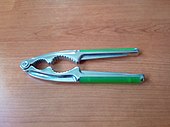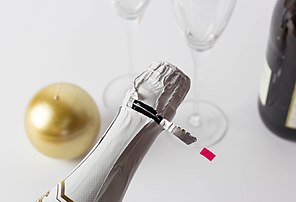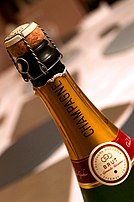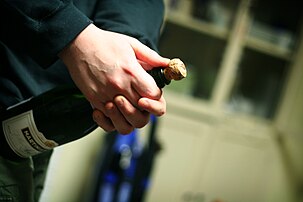Champagne bottle opener

A champagne bottle or champagne bottle opener , short Sektöffner or : Cork , even champagne pliers or champagne pliers , is a product manufactured in various forms, a simple tool for opening a commercial sparkling wine - or champagne bottle . It prevents the cork from being thrown through the air and also avoids or reduces foaming over of the drink.
history
Opening a sparkling wine or champagne bottle is fundamentally different from opening a normal wine bottle and requires a completely different technique. The sparkling wine or champagne cork has the shape of a mushroom . The mushroom head protruding from the bottle is secured with a wire frame (also called a wire basket or wire basket ), the so-called agraffe , so that the overpressure in the bottle does not "pop" the cork prematurely and possibly cause the drink to foam over. Therefore, opening sparkling wine or champagne bottles properly requires some skill.
At the end of the 19th century, “opening aids” came on the market in the form of special, simple tools: For example, a non-fiction book about champagne production that was published by A. Hartleben's Verlag in 1892 describes champagne tongs. The term already existed before (at least since 1870). At the German cutlery manufacturer Zwilling JA Henckels , based in Solingen , a champagne bottle opener was part of the range in 1897, according to the "sample book" at the time. As a result, different types and shapes of sparkling wine and champagne openers developed, which, however, were often only produced for a limited time as niche items .
In the meantime, a bottle of champagne or sparkling wine, definitely a high-quality sparkling wine , is considered perfect to honor a festive occasion. Since champagne or sparkling wine is mostly only available on special occasions, opening a bottle is now often practiced as a “little ritual ”. It is considered stylish to open the bottle without "popping the cork". A sparkling wine or champagne opener can usually be used to ensure controlled and safe opening. The openers are often attributed to the "upscale table culture". Some, sometimes higher-priced models are therefore designed as special design objects and are also considered typical gift items .
A particularly spectacular way of opening is the so-called sabrination - knocking off the head of the bottle with the cork - with the help of a champagne saber . However, the whole neck of the bottle usually breaks off in the case of beginners, so that, according to relevant advice, this method can be used by more experienced professionals such as champagne cellar masters or should be left to waiters .
Types and functioning
With all opening tools, the opening of the bottle must be prepared and in particular the clasp loosened and removed.
→ See the following section #Handling
In addition to some well-known manufacturers, sparkling wine and champagne openers are sold by various smaller manufacturers and trading companies, some of which are patented, and offer individual products such as “champagne tongs”, “champagne star” or “champagne key”.
The three examples mentioned describe the main types and functionality: Most openers work on the principle of pliers by holding the mushroom head of the cork and also increasing the leverage for loosening the cork. Champagne tongs resemble a tong-like nutcracker , some models can be used for both purposes at the same time. Mostly they are hood-shaped in order to additionally secure the cork. There are also twist-grip- type opener models that are attached to the bottle head and clamped onto the mushroom head of the cork, thus increasing the “turning force” acting on the cork. In addition, there are some models that use a type of clamping lever .
They are mostly made of metal , plastic is also sometimes used. Wood can also be found in some of the movements .
The providers of corresponding kitchen and catering utensils include:
- in Germany: AdHoc ; Broszio (brand Durandal ); Robbe & Berking ; Karl Weis ; WMF Group
- in France: Le Creuset ; Sabatier
- in Great Britain: KitchenCraft ( BarCraft brand )
- in Italy: Alessi
- in the Netherlands: Vacu Vin
- in the USA: Champagne Products (in Monrovia, California)
handling
In general, a sparkling wine or champagne bottle should not be pointed at people or fragile objects when opening. In a shaken bottle, the pressure can be around 2.5 bar . A cork that suddenly shoots out with a bang can fly through the air at a speed of up to 40 kilometers per hour and, in the worst case, cause some damage. In addition, "never a corkscrew " should be used with a sparkling wine or champagne bottle , since the overpressure "could make the cork and corkscrew come towards you [...] [and] catch your eye".
The preparation for opening a sparkling wine or champagne bottle - with or without an opening tool - is always the same. Experts such as the French trade association Comité Interprofessionnel du Vin de Champagne recommend the following procedure for "opening as stylishly as possible" - "without popping the cork":
Preparation for opening a sparkling wine or champagne bottle
- The drink should be chilled in the refrigerator for several hours beforehand. The cooler the drink, the lower the tendency to foam over. In addition, the bottle should not be shaken before opening.
- When opening the so-called capsule (cladding of the bottle head including the cork with mostly aluminum foil) must first be removed together with a champagne lid that is often present . This is done by means of a partly integrated tear tape or by cutting the film with a corkscrew .
- Before, during and after removal of the capsule, the cork should be prevented from "shooting out" with the thumb of one hand. With the other hand, the clasp is loosened by untwisting the wire basket loop and pulled off the cork.
Wire frame (agraffe) and champagne lid, with cork
With "tool-free" opening, the bottom of the bottle is then placed on the palm of the hand while the cork is held in place with the other hand. The slightly inclined bottle (but not the cork!) Is rotated in one direction until the cork loosens with a "slight hiss" from the bottle neck.
The use of sparkling wine or champagne openers depends on how they work and is mostly self-explanatory due to the simplicity of the opening tools: The opening aid is attached to the (prepared) bottle head and placed in such a way that the turning or levering force on the mushroom head of the sparkling wine or champagne Can act on the champagne cork.
reception
In post-colonial African Senegal , certain dignitaries who are economically dependent on the former colonial power France take over the "behavior of the European bourgeoisie " as well as African performances of appropriating and imitating the "French savoir vivre " - with the "ceremonial opening of a champagne bottle" being exemplary applies.
The German writer Jean Paul describes Siebenkäs in his novel 1796–97 . Pieces of flowers, fruit and thorns or marriage, death and marriage of the poor lawyer F. St. Siebenkäs in the Reichsmarktflecken Kuhschnappel, among other things, the "feasting luxury" of his protagonist Siebenkäs, who as a wedding guest the "feast" of a "courtly show dinner [ s] ”, during which“ Chammpagner is served late at night ”:“ Opening the bottle is a ritual process that surrounds the aura of liberation in a double sense. The sting helmet, called 'agraffe' in technical jargon, is taken off like armor ”, whereby Jean Paul sees less the“ transience of earthly existence ”but rather the“ surrender of the drinkers to the illusions that champagne has in store for them holds ".
See also
- Champagne saber
- Cash tool
- Corkscrew (for opening wine bottles )
- Bottle opener (for opening bottles with crown caps )
literature
- Ed McCarthy, Mary Ewing-Mulligan: Wine for Dummies . Translation from the American by Michael Liebert; revised by Barbara Mistol; Specialist correction by Robert Lönarz. 5th updated edition. Wiley, Weinheim 2016, ISBN 978-3-527-71268-7 , pp. 127-128.
- Antonio dal Piaz: The champagne production and production of impregnated sparkling wines (= Hartleben's chemical-technical library , vol. 193). A. Hartleben's publishing house, Vienna a. a. 1892, DNB 579613836 , p. 230.
Individual evidence
- ↑ a b c d e f g Ed McCarthy, Mary Ewing-Mulligan: Wine for Dummies. 5th updated edition. Wiley, Weinheim 2016, ISBN 978-3-527-71268-7 , pp. 127-128.
- ^ Antonio dal Piaz: The champagne production and production of impregnated sparkling wines (= Hartleben's chemical-technical library , vol. 193). A. Hartleben's publishing house, Vienna a. a. 1892, DNB 579613836 , p. 230.
- ↑ (newspaper advertisement by Richard Emmer, kk Hof supplier, Stefansplatz (sic!) 7, Vienna). In: foreigners sheet of the imperial and royal capital Vienna / foreigner sheet and tag news of the imperial and royal capital Vienna / foreigner sheet / foreigner sheet with Vedette / foreigner sheet with military supplement Die Vedette , September 11th 1870, p. 15 (online at ANNO ).
- ↑ History of the Zwilling . In: de.zwilling-shop.com . Zwilling JA Henckels , accessed September 4, 2020.
- ^ Franziska Konitzer: Physics in the champagne bottle . In: weltderphysik.de . Welt der Physik, December 31, 2015, accessed September 4, 2020.
- ↑ a b cf. B .: (Weinsnob +): Champagne openers : The 9 best champagne bottle openers In: der-weinsnob.de . December 31, 2015, accessed September 4, 2020.
- ↑ (dpa / oc): Physics: Researchers measure the speed of popping champagne corks . In: Welt.de . December 11, 2008, accessed September 4, 2020.
- ↑ a b Comité Interprofessionnel du Vin de Champagne : Rules for opening the bottle . In: werk = champagne.fr . Retrieved September 4, 2020.
- ↑ a b Kira Welling: Open the champagne bottle: You always did it wrong . In: Focus Online . June 30, 2017, accessed September 4, 2020.
- ^ Cassis Kilian: Occupied black. Postcolonial simulation games in African film . Transcript Verlag (university publication), Bielefeld 2012, ISBN 978-3-8376-2142-6 , p. 78 (also dissertation, Univ. Mainz).
- ↑ Jean Paul : Siebenkäs . Pieces of flowers, fruit and thorns or marriage, death and marriage of the poor lawyer F. St. Siebenkäs in the Reichsmarktflecken Kuhschnappel . Novel. First edition 1796–97. New edition. Insel Verlag, Frankfurt am Main 1987, ISBN 3-458-32680-4 .
- ↑ Quoted from: Tanja Rudtke: Kulinarische Lektüren . From eating and drinking in literature . Transcript, Bielefeld 2014, ISBN 978-3-8376-2374-1 , pp. 46–53.
Web links
- Rules for opening the bottle. In: champagne.fr. Comité Interprofessionnel du Vin de Champagne .
- Kira Welling: Open the champagne bottle: You always did it wrong. In: Focus Online . June 30, 2017 .






